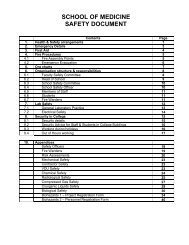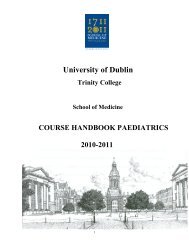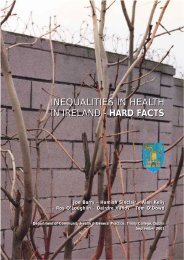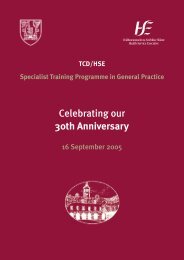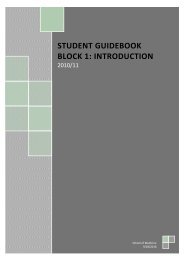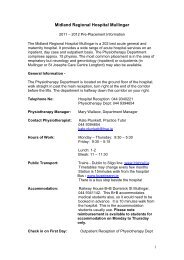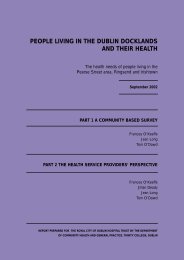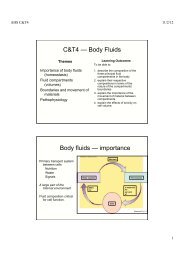people living in finglas and their health - School of Medicine - Trinity ...
people living in finglas and their health - School of Medicine - Trinity ...
people living in finglas and their health - School of Medicine - Trinity ...
Create successful ePaper yourself
Turn your PDF publications into a flip-book with our unique Google optimized e-Paper software.
RESULTS - PART 1<br />
RESULTS - PART 1<br />
The primary carer reported that, <strong>of</strong> those who were wait<strong>in</strong>g for <strong>health</strong> care 35% awaited an outpatient<br />
consultation <strong>and</strong> 29% awaited surgery (Figure 3.13). Almost seven out <strong>of</strong> every ten were wait<strong>in</strong>g for more than<br />
three months. Over two thirds <strong>of</strong> the primary carers thought that the wait<strong>in</strong>g time was unacceptable (Table 3.32).<br />
A similar proportion <strong>of</strong> household members who were wait<strong>in</strong>g for <strong>health</strong> care were <strong>liv<strong>in</strong>g</strong> <strong>in</strong> less deprived areas<br />
<strong>and</strong> more deprived areas (26/443, 5.9% versus 37/519, 7.1%, p=0.4).<br />
Figure 3.13 Type <strong>of</strong> treatment awaited by household members as reported by primary carers (n=63)<br />
PERCENTAGE<br />
40<br />
35<br />
30<br />
25<br />
20<br />
15<br />
10<br />
5<br />
0<br />
34.9<br />
Consultation<br />
28.6<br />
Surgery<br />
TYPE OF TREATMENT AWAITED<br />
19.1<br />
Dentist<br />
Factors associated with those wait<strong>in</strong>g for <strong>health</strong> care<br />
9.5 7.9<br />
Speech/<br />
physio/OT<br />
Medical<br />
Bi-variate analysis us<strong>in</strong>g six groups <strong>of</strong> variables (demographic characteristics, socio-economic characteristics,<br />
chronic illness, disability, <strong>health</strong> related behaviours, <strong>and</strong> <strong>health</strong> services utilised) <strong>in</strong>dicated that several factors<br />
were significantly associated with reported wait<strong>in</strong>g for <strong>health</strong> care at the time <strong>of</strong> the survey.<br />
Logistic regression models were constructed to clarify the <strong>in</strong>dependent associations between the significant<br />
variables <strong>and</strong> the likelihood <strong>of</strong> reported wait<strong>in</strong>g for <strong>health</strong> care at the time <strong>of</strong> the survey (Table 3.33). The<br />
relationships presented are those that rema<strong>in</strong>ed statistically significant or were deemed cl<strong>in</strong>ically important after<br />
tak<strong>in</strong>g account <strong>of</strong> confound<strong>in</strong>g. The associations are expressed as odds ratios adjusted for confound<strong>in</strong>g.<br />
Table 3.33 Logistic regression model to identify determ<strong>in</strong>ants <strong>of</strong> those wait<strong>in</strong>g for <strong>health</strong> care <strong>in</strong> the F<strong>in</strong>glas<br />
population (63/963)<br />
Total Await<strong>in</strong>g Proportion % Adjusted p-value<br />
<strong>health</strong> care<br />
Odds ratio<br />
(95% CI)<br />
Used a hospital service <strong>in</strong> the 12 months prior to the survey<br />
No 635 26 4.1 1<br />
Yes 319 37 11.6 2.4 (1.4 to 4.2) 0.002<br />
Miss<strong>in</strong>g 9<br />
Whole model χ2=271, p






